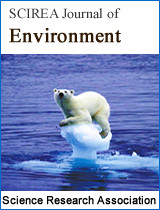Effect of Spent Lubricant on the Mortality rate of Earthworm (Lumbricus terrestris) in Obio/Akpor L.G.A, Rivers State
DOI: 237 Downloads 15643 Views
Author(s)
Abstract
A 4- week toxicological study was conducted to ascertain the effect of spent lubricant on the mortality rate and physiological function of Earthworm (Lumbricus terrestris). A total of 50 Earthworms of weight ranging from 0.3g-0.7g each were collected and acclimated in a test soil for 2 weeks after which they were used for acute and sub-lethal bioassay. The experiment which consisted of five groups and four treatments were laid out in a randomized block design. An acute toxicity test at concentration of 0ml/kg (control); 50ml/kg; 100ml/kg; 200ml/kg and 400ml/kg with an exposure period of 96 hours was carried out. Similarly, sub-lethal toxicity test was also conducted for a period of 30 days at a concentration of 0ml/kg (control), 7ml/kg, 13ml/kg, 20ml/kg and 27ml/kg respectively. Results revealed that in both tests, Lumbricus terrestris were sensitive to varying concentrations of used lubricants but were able to survive for a few hours at concentrations higher than 100ml/kg. The study revealed that Earthworm survival could serve as suitable indices to assess engine oil pollution in soil.
Keywords
Earthworm, acute toxicity, sub-lethal toxicity, spent lubricant, concentrations
Cite this paper
Daniel, U.I, Otu, P.,
Effect of Spent Lubricant on the Mortality rate of Earthworm (Lumbricus terrestris) in Obio/Akpor L.G.A, Rivers State
, SCIREA Journal of Environment.
Volume 3, Issue 5, October 2019 | PP. 185-193.
References
| [ 1 ] | Curry, J.P. (1994). Grassland invertebrates: Ecology, influence on soil fertility, and effects on plant growth. Springer. |
| [ 2 ] | Eijsackers, H and Doelman,P. (1987). The impact of heavy metals on the terrestrial ecosystems: biological adaption through behavioural and physiological avoidance, ecological assessment of environmental degradation. Pollution and Recovery, pp 245-259. |
| [ 3 ] | Ezeronye,O.U and Ubala, A.U. (2005). Studies on the effect of abattoir and industrial effluents on heavy metals and microbial quality of Aba River Nigeria. African Journal of Biotechnology.:4 (3): 226-272 |
| [ 4 ] | Maike,S and Filser, J. (2007). The influence of earthworms and organic additives on the biodegradation of oil contaminated soil. Applied Soil Ecology, 36: 53-62 |
| [ 5 ] | Safwat,H., Shakir,H and Weaver, R.W. (2002). Earthworm survival in oil contaminated soil. Plant and Soil, 240: 127-132. |
| [ 6 ] | Saterbak, A and Toy, R.J. (1999). Ecotoxicological and analytical assessment of hydrocarbon contaminated soils and application to ecological risk assessment. Environmental Toxicology and Chemistry, Vol.18,no.7, pp.1591-1607 |
| [ 7 ] | Shin, K.H.and Jung, H. (2005). Earthworm toxicity during chemical oxidation of diesel contaminated sand. Environmental Toxicology and chemistry, vol. 24, no. 8, pp.1924-1929. |
| [ 8 ] | Udom, B.E., Ano, A.O., and Chukwu, W. (2012). Contaminant limit (c/p index) of heavy metals in spent oil contaminated soil bioremediated with legume plants and nutrients. Journal of Soil Science, 22:144-152 |

